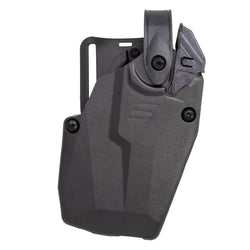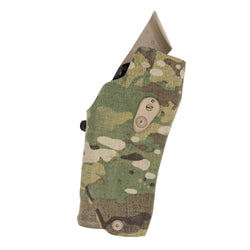Too many people obsess over keeping their guns clean and lubricated while completely ignoring the rest of their gear. It’s great that you clean your gun every time you shoot it, but ignoring your gear, specifically your holster, is a setup for failure. Let’s talk about holster maintenance and what you can do to ensure you get years and years of reliable operation out of it.

How to maintain a holster? There is no single answer. Holsters differ more than guns, and various designs, features, and materials require different levels of care. Luckily, it’s all fairly simple and doesn’t require much effort.
If you can wash dishes and clean boots, you can maintain your holster. Maintaining the holster is one part of the challenge; the other is keeping it serviceable. Holsters, like boots, don’t last forever. Eventually, they wear out, but proper maintenance will extend their service life.
Holster Maintenance 101: Basic Cleaning
Holster maintenance is fairly straightforward, and we’ll break it down by holster design. The two main types of holsters we’re discussing here are polymer materials, like SafariLaminate and SafariSeven, and classic leather designs.
SafariLaminate and SafariSeven
Safariland’s polymer blends are used in their line of duty holsters—some of Safariland’s most popular holsters overall, and the leading duty holsters in the United States.
Ease of Maintenance
One of the key benefits of these holsters is how easy they are to care for. SafariLaminate and SafariSeven can be cleaned with a damp cloth and either powdered or liquid soap. When it comes to cleaning your holster, less soap is often more.

Avoid using harsh chemicals. These can damage the finish of custom wraps or compromise the durability of the polymer materials.
Retention Systems and Maintenance
SafariLaminate and SafariSeven holsters are commonly equipped with active retention systems. These systems, especially the SLS (Self Locking System), require routine holster maintenance to stay reliable.
The SLS system uses a combination of polymer and metal components and is designed to be pressed down and then forward to release the firearm.

If the SLS system is exposed to mud and the mud remains wet, it’s a good idea to flush it out with warm water as soon as you can. While rinsing, rotate the hood repeatedly until it functions smoothly.
For dry dirt, grit, or dried mud, we have a slightly different step. Grab a can of WD-40 with a straw applicator. Spray into the mechanism while rotating the hood to clear out debris and restore smooth function.

After you clean the holster of mud or dirt, it’s a good idea to apply a little gun oil to the moving parts for lubrication.
Leather Care
If you’re rocking a holster from our partners at Bianchi, it’s wise to know a little about leather holster maintenance. It’s not difficult, but it’s different from caring for synthetic holsters.
Basic Cleaning
You can use a damp cloth for a general wipe-down, but limit it to the outside of the holster. Keep the inside dry by using a dry rag or even a new, dry toothbrush to clean the inside of your holster.

What to Do If It Gets Wet
If your leather holster gets wet, allow it to air dry indoors at room temperature. Do not expose it to artificial heat of any kind, or you risk it cracking and shrinking.
Use Leather-Specific Products
A dedicated leather cleaner is the best choice when it comes to cleaning and caring for leather. Leather cleaners and polishes can clean the holster, protect the holster from water, and generally keep the rig running longer and safer.
Avoid using any products that can soften the leather.
Holster Maintenance 102: Inspection
Outside of just keeping your holster clean, you should routinely inspect it for serviceability.
Check the Hardware
Most modern duty holsters don’t change much. What you need to pay attention to is the hardware. Modern duty holsters rely on screws and fasteners to lock the holster to various mounting platforms, and those fasteners should be part of your daily inspection.

Make sure the screws are tight and in place. If you have screws that are consistently loose, it might be time to Loctite those screws in place (avoid permanent threadlockers).
Also, regularly inspect the mounting hardware that connects to your belt or any other rig. If you spot any deformity, cracking, or anything odd, replace it. It’s always safer to replace the mount than risk anything using a potentially deformed mount.

Inspecting Leather Holsters
Leather holsters can be a little trickier. You’ll need to inspect the molded shape of the holster. If it loses its stiffness and becomes more like a bucket than a holster, you have problems.
When a leather holster loosens up, the retention begins to loosen, but worse than that, the leather portion of the holster can then flex. In worst-case scenarios, it can flex inward and interact with the trigger, which can potentially cause an accidental discharge.
Inspect leather holsters for looseness, as well as flex and cracking.
Disinfecting Your Gear
The whole reason I’m writing this holster maintenance article is that a friend and local police officer was exposed to blood. This contact extended to his holster, and he wanted to know how to safely disinfect his holster. From there, we got into the dirty details of cleaning his duty rig.
How to Disinfect a Holster
Disinfecting your gear isn’t too tough. Start with a basic cleaning using a damp cloth and soap to remove move surface grime. Beyond that, you want to employ either Lysol or antibacterial soap. Personally, Lysol wipes are my go-to and and that’s what we used to ensure my friend’s duty rig is good to go.

In general, you only want to use EPA-registered disinfectant chemicals, but some listed chemicals may damage the finish of the holster. Some chemicals, like bleach, can damage the holster’s finish if not properly diluted.
After disinfecting, you can wipe or air dry your holster. It’s critical that the holster is completely dry before use.
Keeping Clean
“Weapon, gear, body”—that’s the maintenance mantra of the United States Marine Corps. That might not be necessary for the average Joe, but the principle holds. Regular cleaning and inspection of your gear ensures it will perform when you need it most.











